July 18, 2018 marks the 100th anniversary of the birth of Nelson Mandela. Each year, the world celebrates this extraordinary man on his birthday, which is today known as Nelson Mandela International Day.
For this centenary occasion, the theme is "Action Against Poverty," honoring Mandela's ideal of "a democratic and free society in which all persons live together in harmony and with equal opportunities."1
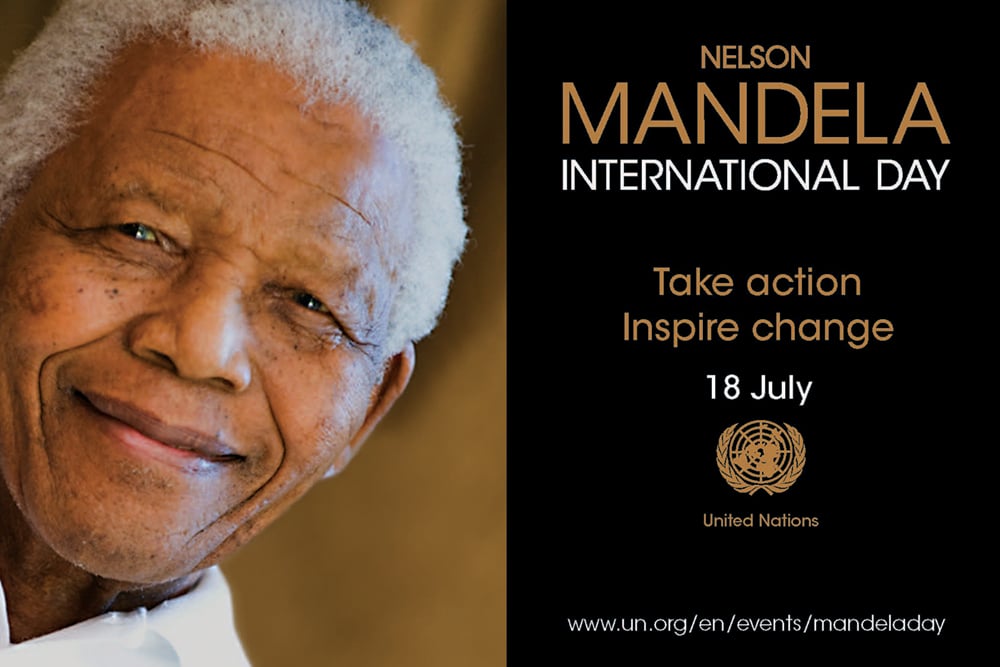
Photo: Created by the UN.
While Mandela is perhaps more widely known as a president of South Africa, his legacy was built over many decades fighting for freedom and justice.
Early Life in South Africa
Mandela was born in Mvezo, South Africa in 1918 into a society strongly influenced by racism and active segregation. Slavery had been abolished in 1834 in the British-controlled Cape Colony, but was replaced by laws like the Master and Servant Act that preserved the racially-decided social hierarchy. Indigenous peoples were used for harsh labor and granted little to no freedom.
In 1910 the British colonials and the Afrikaners created a nation based in white supremacy and suppression of native South Africans' human rights. Under the Union of South Africa, formal discriminatory and segregation laws, like the Natives' Land Act of 1913 and the Natives (Urban areas) Act of 1923 were imposed on South Africa's non-white citizens.
Apartheid Becomes Law
Daniel François Malan, a member of the National Party, became the Prime Minister of South Africa in 1948 (the discriminatory laws set forth prior to apartheid kept most non-whites from voting in the 1948 elections), and with him apartheid became official.
Apartheid systematically segregated South Africa, eventually leading to the forced removal of millions of people from their homes to Bantustans, with the end goal of denying citizenship to all non-whites. During this tumultuous time, Mandela was gearing up to stand for the freedom of himself, his family, his countrymen, and all people.
Mobilizing Youth
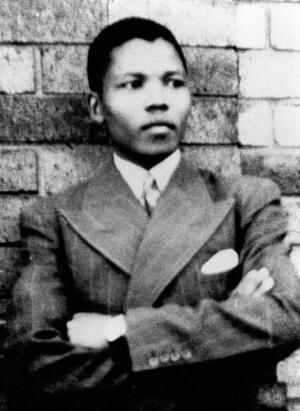 In 1944, Mandela joined the African National Congress (ANC), the political party opposed to the National Party, and helped establish the African National Congress Youth League (ANCYL) with the belief that the youth could help mobilize Africans to fight for their rights.
In 1944, Mandela joined the African National Congress (ANC), the political party opposed to the National Party, and helped establish the African National Congress Youth League (ANCYL) with the belief that the youth could help mobilize Africans to fight for their rights.
Mandela was elected National Volunteer-in-Chief for the Defiance Campaign in 1952. The Defiance Campaign was a nonviolent resistance campaign formulated to encourage all suppressed by the current government to join the fight without risking their lives. Mandela quickly became a well-known political figure pushing back against apartheid thanks to the campaign and his rallying efforts.
Throughout the next decade, Mandela, the ANC, and other activist parties continued to fight racial injustice through protests, public speeches, and rallies. During one organized demonstration, the police fired on the protestors, resulting in the death of 69 people. This is known as the Sharpeville Massacre, and it brought heightened international attention to apartheid.
Photo: A young Nelson Mandela, 1937.
Building a Movement
Mandela spent a lot of the later 1950s and early 60s in hiding, while organizing resistance movements and efforts. In 1962, Mandela traveled to multiple African countries and England to meet with prominent leaders and anti-apartheid activists, and to gather funds and support for anti-apartheid military efforts in South Africa.
I have chosen this… course, which is more difficult and which entails more risk and hardship than sitting in gaol. I have had to separate myself from my dear wife and children, from my mother and sisters, to live as an outlaw in my own land. I have had to close my business, to abandon my profession, and live in poverty and misery, as many of my people are doing. ... I shall fight the government side by side with you, inch by inch, and mile by mile, until victory is won.
The struggle is my life. I will continue fighting for freedom until the end of my days.
-- Mandela's press statement issued while underground in South Africa on June 26, 1961
Capture and Imprisonment
On August 5, 1962, Mandela was captured by South African police and was sentence to five years for inciting workers' strikes and leaving the country without permission. Then in 1964 the South African government allegedly found plans for sabotage which Mandela had been a part of. He and two others were found guilty on four charges of sabotage and conspiracy to violently overthrow the government, and were sentenced to life imprisonment. Mandela, representing himself in both trials, took them as an opportunity to share his political views and encourage the fight to continue. These trials brought international attention to the issue of apartheid and Mandela's fight for freedom.
I have cherished the ideal of a democratic and free society in which all persons live together in harmony and with equal opportunities. It is an ideal which I hope to live for and to achieve. But if needs be, it is an ideal for which I am prepared to die.
-- Mandela's opening statement at the Rivonia Trial in Pretoria, South Africa on April 20, 1964
For the next 26 years, Mandela remained imprisoned.
The Call for Mandela's Release
During his time in prison, Mandela continued fighting for justice, and took up other causes, like improving prison conditions. He started his autobiography, corresponded with and gave advise to anti-apartheid activists, and worked on a Bachelor's of Law degree.
On the international scene, many countries supported anti-apartheid efforts (like restricting trade with South Africa and stopping investment in South African companies), and in the wake of his 60th birthday in 1978, "Free Mandela!" campaigns were held around the globe.
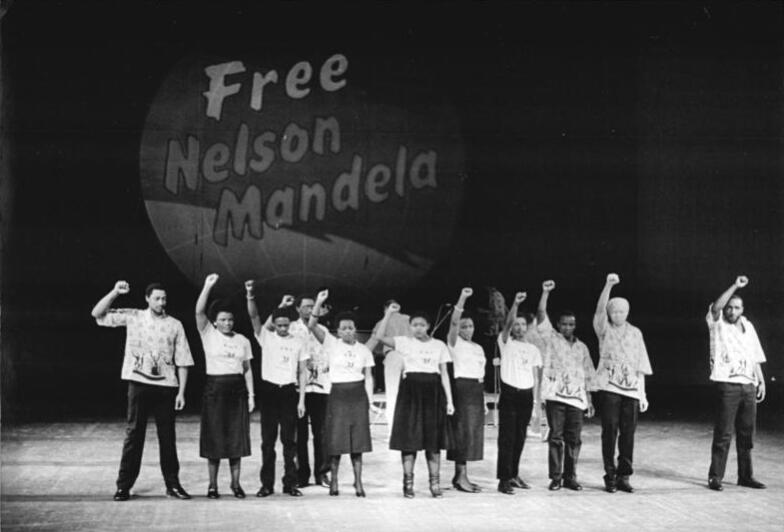
Photo: A group supports the "Free Mandela!" campaign in Berlin, Germany, 1986.
During the 1980s, violence hit a high in South Africa and more and more pressure was put on the government to end apartheid and free Mandela. This tumultuous time made Mandela's 70th birthday in 1988 even more of a rallying point than his 60th.
Mandela's Release
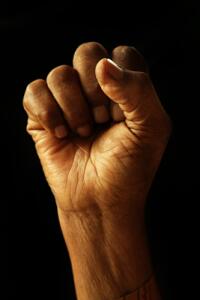 In 1989, the then South African leader, a member of the National Party (which had been in charge since the election of Malan in 1948), suffered a stroke and was replaced by F. W. de Klerk. De Klerk, also a member of the National Party, met with Mandela in December of 1989 and the two spoke of how to end the violence.
In 1989, the then South African leader, a member of the National Party (which had been in charge since the election of Malan in 1948), suffered a stroke and was replaced by F. W. de Klerk. De Klerk, also a member of the National Party, met with Mandela in December of 1989 and the two spoke of how to end the violence.
In February of 1990, all formerly banned political parties were legalized and many anti-apartheid prisoners were released. On February 11, Nelson Mandela left prison as an unconditionally free man. He was greeted by hundreds of thousands of people in South Africa, and millions more across the globe.
Our march to freedom is irreversible. We must not allow fear to stand in our way.
-- Mandela's statement upon release from prison in Cape Town, South Africa on February, 11 1990
Mandela immediately started working with the ANC to promote a new South Africa based on equality and liberty for all. He was elected president of the ANC once again and ordered a ceasefire, calling instead for peaceful negotiations with the National Party. Mandela traveled the world, meeting with leaders and activists in many countries and encouraging more international pressure to end apartheid.
Photo: Nelson Mandela's hand in the iconic "Defiance Campaign" salute. UN photo by Matthew Willman.
The End of Apartheid and the Establishment of a Democratic Government
From his release in 1990 to the official end of apartheid in 1994, Mandela remained at the front of negotiations with all political parties in South Africa, working closely with de Klerk to find a resolution that was beneficial and fair to all in South Africa.
They agreed upon a liberal democratic model, with a constitution that guaranteed separation of powers, a constitutional court, and a bill of rights, and included provincial-level governance. The first democratic election in South Africa took place on April 27, 1994.
Mandela won the election as the ANC candidate with 63 percent of the vote, and on May 10, 1994 he was inaugurated as the first black president of South Africa.
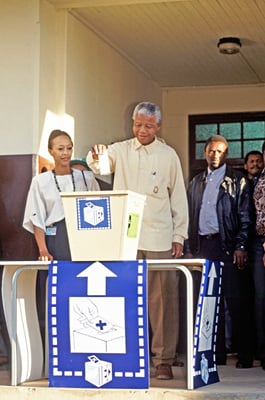
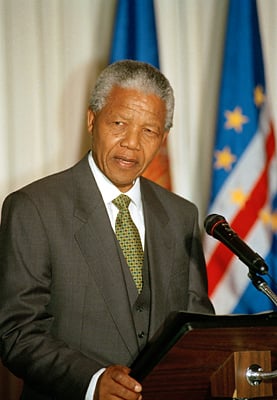
Left photo: Nelson Mandela casts his vote during the 1994 general elections. UN photo by Chris Sattlberger. Right photo: Nelson Mandela, President of South Africa, addresses the UN General Assembly. UN photo by Evan Schneider.
During his time in office, Mandela focused on reconciling the splintered country. He appointed de Klerk as the Deputy President and worked with other leaders of prominent political parties in South Africa to ensure that all were well represented in the building of the democracy.
Mandela's Legacy
Following his single term in office (he declined to run again), Mandela continued his fight for social justice for all until his passing on December 5, 2013.
On Nelson Mandela International Day, Planet Aid salutes this great man's fortitude, commitment, and ceaseless drive to abolish poverty and oppression and instill hope for the marginalized masses. His legacy will remain an inspiration for generations to come, especially for those working to carry on his fight in the development sector.
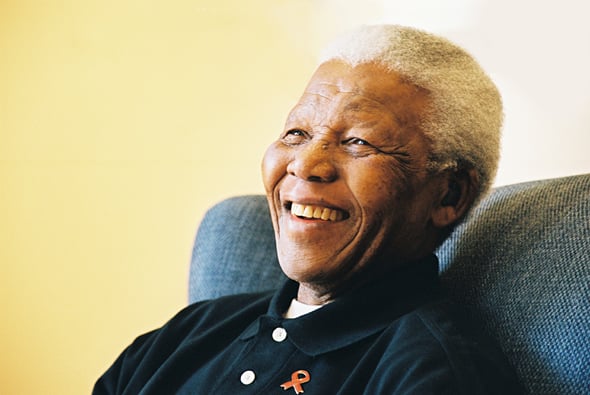
Photo: Nelson Mandela in 2005. UN photo by Matthew Willman.
1Taken from Mandela's statement made in Pretoria, South Africa on April 20, 1964.
